Death by Corset: A Nineteenth-Century Book about Fatal Women’s Fashions (and Animal Physiology)
Normally at the BHL we examine zoology-related books in our Book of the Week posts, but this week we’re entering new territory and taking a look at a comparative physiology book that examines the only species to mutilate its own body: Homo sapiens.
If you go by what J. L. Comstock, M.D., had to say in 1848 about what it was like to be a lady, times were difficult. In this week’s book of the week, Outlines of Physiology, both Comparative and Human; in which are Described the Mechanical, Animal, Vital, and Sensorial Organs and Functions; Also, The Application of These Principles to Muscular Exercise, and Female Fashions and Deformities, Comstock explains that young women were under enormous pressure to be aesthetically pleasing to men (not a bad goal, he points out), and this pressure to look good by wearing a corset or stays was causing rampant deformities, illness, and even death: “. . .I have no doubt that the ladies themselves, to a considerable extent, will agree with me in believing, that hundreds, nay thousands, of females literally kill themselves every year by this fashion in our own country: and if suicide is a crime, how will such escape in the day of final account!” (311).
While he may have thought that women who died of tight-laced corsets were going to hell, he did sympathize with their goal to look beautiful for men: “what possible motive could have induced the females of the present age, and especially those of these United States (where ultraism in respect to this deformity [by corset] is carried to a much greater extent than in any other country). . .Can it be for the purpose of making themselves more agreeable, and more acceptable to the lords of creation? Then certainly their motives ought to meet with the law of kindness, and the tortures through which they are willing to pass in order to arrive at perfection—the sympathy and commiseration of those for whom such perils are encountered” (321).
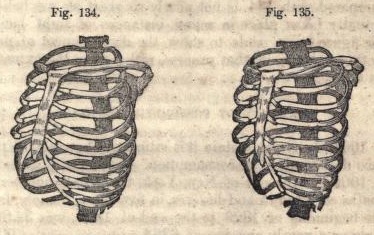
Comstock explains: “We have represented by figures 134 [normal skeleton] and 135 [deformed skeleton] the difference between a natural human skeleton, and one in which the pressure of stays has pushed the front ends of the ribs inward, bending the soft cartilages, so as to make them form acute angles outward” (311-312). This results in the ribs pressing inward upon the lungs.
The force of a tight-laced corset upon the ribs caused them to create pressure not only upon the lungs, but also the other internal organs which undergo a shifting in position to accommodate for the new skeletal shape. This illustration from 1884 represents the contemporary medical opinion about organ displacement due to corset wearing.
Ann Buermann Wass and Michelle Webb Fandrich, two fashion historians, describe what corsets looked like during Comstock’s period:
“By the 1840s, the line of women’s corsets extended to well below the waist. The corset of the 1840s and 1850s was boned throughout with whalebone and, as it had been in decades prior, outfitted with a metal, wood or whalebone busk at the center front. Commenting on the gradual lengthening of the corset in 1841, the Handbook of the Toilet noted that “[t]he modern stay extends not only over the bosom but also all over the abdomen and back down to the hips…they have been growing in length by degrees”. . .By this time, corsets had lost their shoulder straps and were most commonly fastened up the front with busk outfitted with clips and laced up the back to achieve a more precise fit.” (306)
An early example of a stay, a type of corset with shoulder straps made of thick material. This particular example is a woman’s corset from France, c. 1730-1740, made in a silk plain weave with supplementary weft-float patterning. From the Los Angeles County Museum of Art.
A corset ad from 1898 developed by Earnest Elmo Calkins for R & G Corset Company. This corset represents the longer shape described by Wass and Fandrich.
The deformities caused by stays and corsets were a serious problem for Comstock, not only because they could result in death but because he believed that children born of corset-wearers were weak, small and sickly; this is owing to Comstock’s belief that corsets deplete the mother’s milk supply: “[the breasts of a corset- or stay-wearer] present a mere pretence, a nullity, a source of starvation, rather than one of sustenance, to the nascent beings, who are so unfortunate as to be thrown upon such cotton and wool resources of existence” (320-321).
Figure 136 represents an ideal woman who does not wear a corset or stays and can thus produce breast milk and strong children. Figure 137 represents the typical woman contemporary to Comstock who wears stays and thus cannot produce breast milk or healthy children, according to the M.D. (320).
And shoulder-baring dresses? Ladies, forget about it! Comstock notes that:
“the] cause of distorted shoulders. . .is the recent fashion of dressing so wide across the neck as to leave one, or perhaps both the acromion processes, or shoulder tips, in a state of entire nudity. . .The consequence of this fashion was, that, judging from the perpetual motion of [the shoulders], the wearer constantly felt as though her dress was in danger of slipping down, and which she made as constant efforts to prevent, or to ascertain by feeling with the shoulder whether this was the case, or not, until these motions became habitual, and therefore insensible. . .until [one shoulder] became permanently higher than the latter.” (296-7)
Comstock’s only hope to ending the serious deformities and risk for death caused by stays, corsets and fashionable clothing was that the country simpletons who didn’t know that corsets were fashionable would move to the city and literally create a new race of revitalized humans: “It is true that there are parts of our country where the practice of excessive lacing, and therefore its degenerating consequences do not exist; and whence we are happy to know that many of the daughters of unsophisticated nature are transplanted into our cities, there to become the fostering angels of a renovated species” (321).
While Comstock also explores similarities between human and animal physiologies in his book, a large part of his focus is on remedies for men and women to avoid illness. Among Comstock’s recommendations for different forms of “exciting exercise” for adults and children to prevent illness are “field-sports,” angling, riding, calisthenics and archery—but also “cheerfulness” and “laughing” (239-266).
And ladies, while he doesn’t want you to wear a corset during your archery practice, don’t forget to wear your long-sleeve, floor-length gown with giant feathered hat (270).
If you are sitting at a desk right now while you read this, beware that you don’t become the lazy, deformed, lolling, school-girl type described by Comstock in his section on the evils of the seated posture:
“One posture which school-girls are exceedingly apt to take, is that of leaning forward, and placing the elbow on the desk for support; and this they often do, even when their seats are provided with backs. This posture, if continued so as to form a habit, will often show its effects on all occasions, the young lady having such a disposition to lean, as to indulge it when any support happens to be near where she sits, let the place or company be what it may. Such a one will lean, with the hand supporting the head, when at home, on a table, or window-stool, or any other convenient lolling-place, for hours together.” (294)
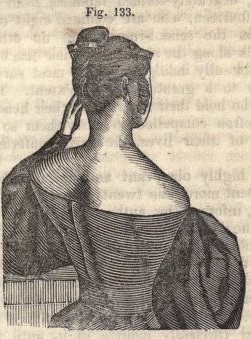
If you spend your time leaning with your head in your hand while sitting, you can look forward to deformed shoulder blades, according to Comstock, “one of which is sometimes thrown so far out of place as to give it the appearance of absolute dislocation” as in Figure 133 (294-295).
While Comstock’s pronouncements and prescriptions may seem amusing, corsets and stays presented a very real danger in the minds of many of his contemporaries. Comstock’s descriptions of the physiological changes caused by corsets were sometimes accurate, such as his description of compressed lungs and organs, which resulted in difficulty breathing and could make recovery from any underlying illness harder. Valerie Steele, a fashion historian, explains 19th-century beliefs about the dangers of corsets:
“The corset has been blamed for causing dozens of diseases, from cancer to curvature of the spine, deformities of the ribs and displacements of the internal organs, respiratory and circulatory diseases, birth defects, miscarriages, and “female complaints,” as well as medical traumas such as broken ribs and puncture wounds. The Lancet, Britain’s most important medical journal, published more than an article a year from the late 1860s to the early 1890s on the medical dangers of tight-lacing. Deaths from tight-lacing were also mentioned. In one case, for example, the “heart was found to be so impeded in its action as to render life impracticable.” (67)
Today, corsets are still in fashion among people interested in recreating historical costume, and also among various different types of lingerie enthusiasts. Regardless of one’s beliefs about the safety or practicality of corsets, they present a fascinating reflection of human beliefs about beauty and the ability to manipulate the human body.
References:
Comstock, J.L. Outlines of Physiology, both Comparative and Human; in which are Described the Mechanical, Animal, Vital, and Sensorial Organs and Functions; Also, The Application of These Principles to Muscular Exercise, and Female Fashions and Deformities. New York: Pratt, Woodford & Company, 1898.
Steele, Valerie. The Corset: A Cultural History. New Haven, CT: Yale University Press, 2003. p. 67.
Wass, Ann Buermann and Michelle Webb Fandrich. Clothing through American History: The Federal Era through Antebellum, 1786-1860. Santa Barbara, CA: Greenwood, 2010. p. 306.


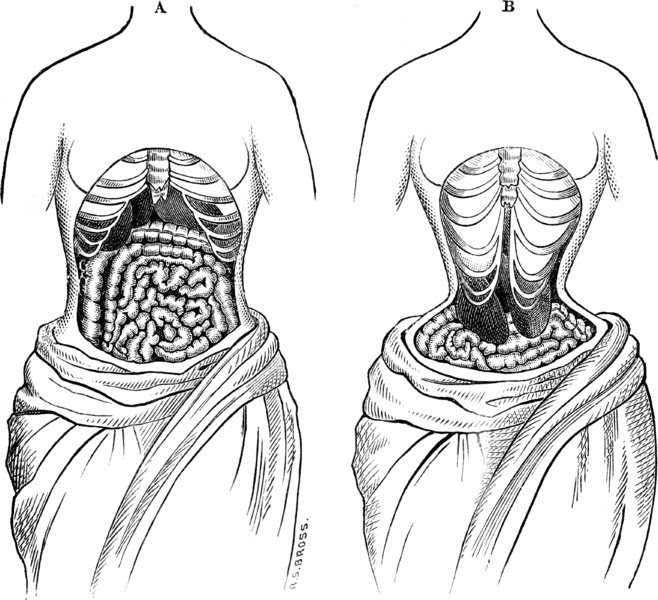
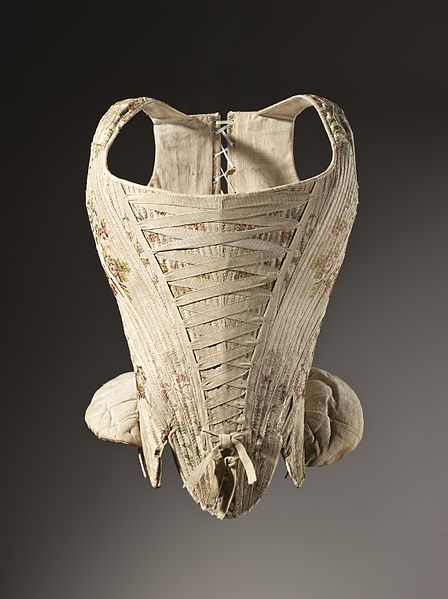
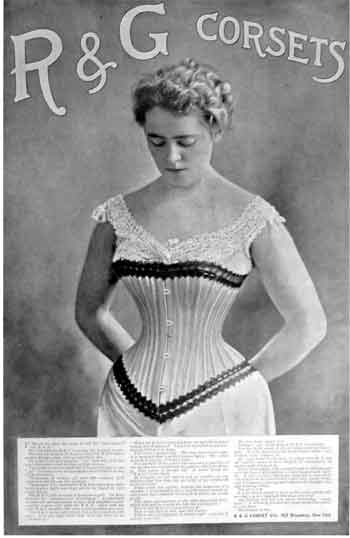
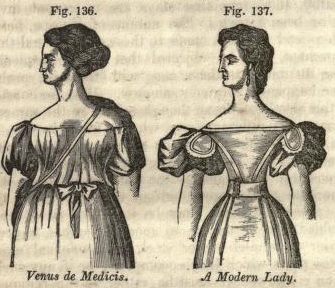




Girdles are dangerous too. They crush your insides.
nice post